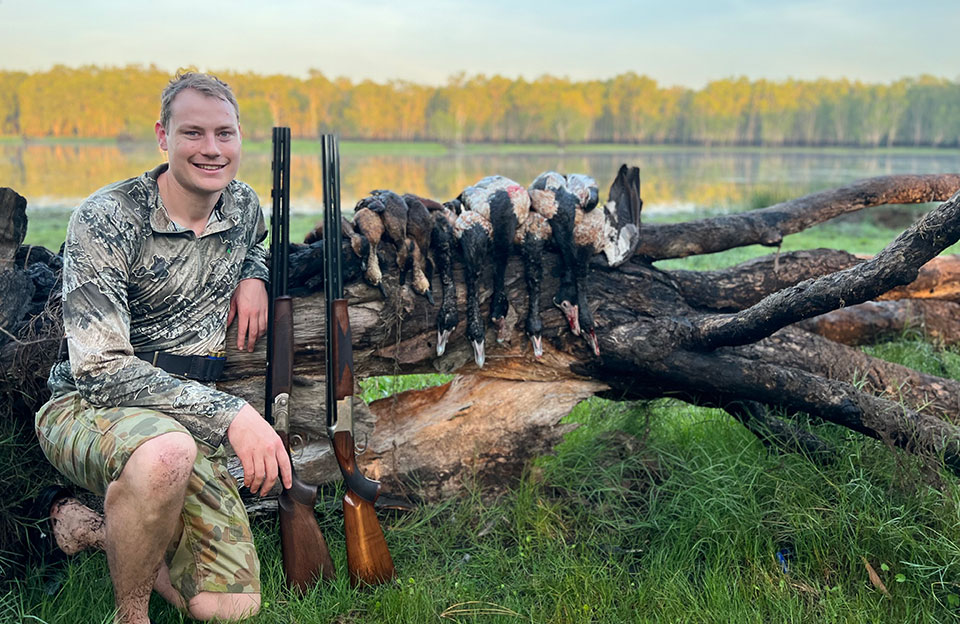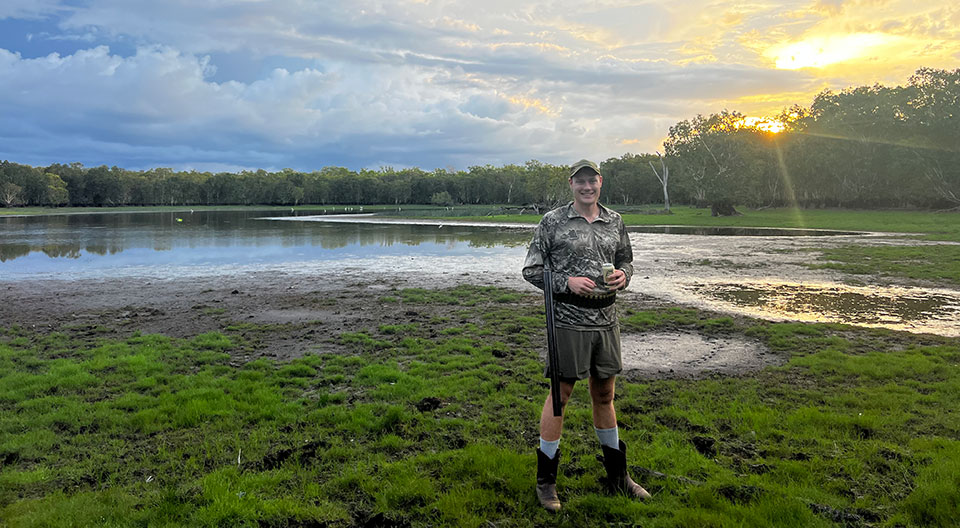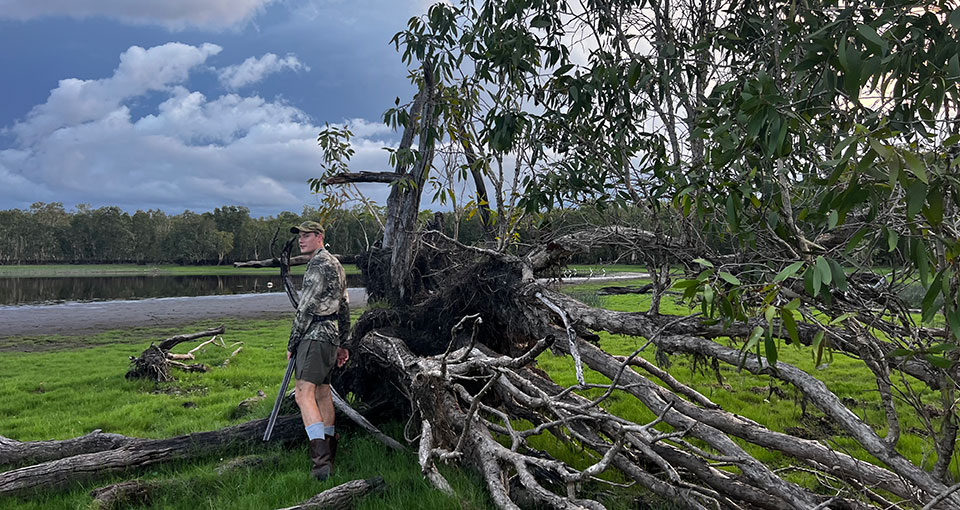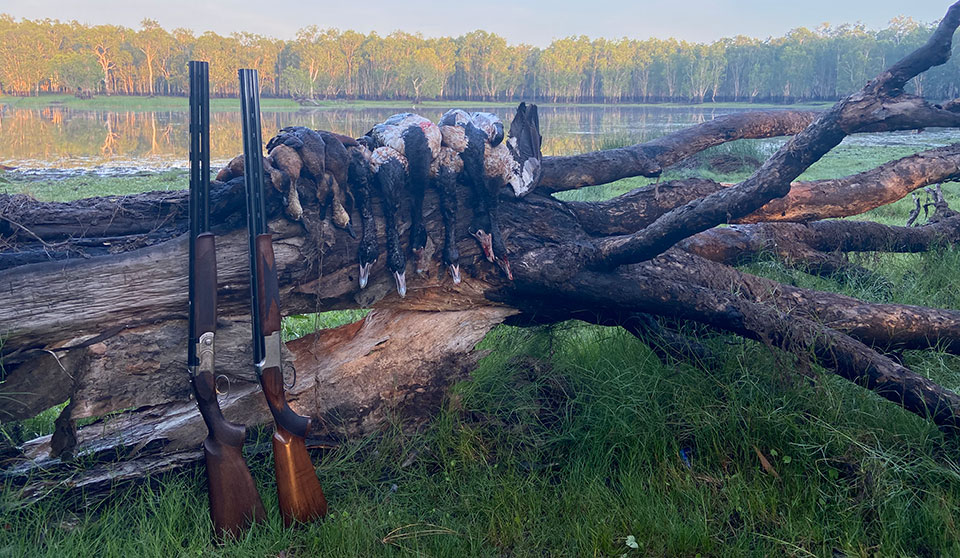Sweat drips into my eye again, another mosquito bites me through the thin camouflage shirt. I dare not move from where I remain tucked behind the gnarled trunk of a long-dead eucalypt tree. My eyes are fixed upwards beyond the glistening paperbark fringed water to the dawn sky which glows in all shades of orange, purple and green.
What captivates me most is the ‘V’ I can see up there, slowly getting closer to me and occasionally emitting a faint honk. I tuck deeper into my hide and blow into my call, willing this little sound to carry over the vast wilderness and tempt the lead goose in my direction. It works. As the geese are almost above us Andrew and I burst from cover, shoulder our guns and take a bird each from the pack. The thud of the geese hitting the muddy bank of the billabong startles a group of whistling ducks into flight who then head towards last night’s still visible moon. Andrew and I grin at each other, forever enthralled by the opportunity to hunt in such a magic setting.
It can’t claim to have same cultural significance or well-heeled ceremony of the glorious 12th, but the first week of September and the beginning of the Northern Territory (NT) waterfowl is no less eagerly awaited by those living in the top end of Australia. Early mornings goose shooting are a welcome reprieve in an otherwise sweltering time of year known as the ‘build up’.

Temperatures average well above 35 degrees Celsius and humidity hovers around a perfect 100%. The rains will arrive soon and breath life back into the floodplains and cool the blistering sun. However, the relative scarcity of water in the floodplains of the 19,816 km2 Kakadu National Park this late in the dry season pushes the birds north towards the coastal hunting areas in search of food and creates a mecca for wildfowlers.
The magpie goose (Anseranas semipalmata) is the sole living representative species of the family Anseranatidae and only exists in northern Australia and Papua New Guinea. However, in those humid tropics the species thrives and between one-point-five and three million of these wild birds make their home and breed in the vast floodplains of the NT each year.
Their black and white plumage and yellowish legs accompanied with their unique honking sound makes them unmistakeable. In Yolŋu Matha (Aboriginal language) the bird is known as gurrumaṯtji and has been a treasured part of Indigenous Australians’ diet for millennia.
4.00 am - ‘Bing’ goes Apple’s default alarm tone. Jarring me awake in the pre-dawn darkness as the same melody has done on countless other days of adventure. As the kettle boils we load our Beretta 12 bores and a slab of falcon No# 1 steel shot into the pickup, throw in an Esky full of ice and then finally fill our Yeti mugs with steaming hot coffee for the road.

Darwin City quickly slips behind us as we head south on the Stuart Highway before turning onto the Arnhem Highway and flicking our powerful spotlights on to avoid hitting any Kangaroos on the early morning road. Finally, we head north of the highway on a corrugated dirt track which leads to a billabong adjacent to, and fed, by the floodplains of the mighty Adelaide River. As the pickup comes to a rest amongst the pandanus fringing the water I turn the ignition off.
Rather than being greeted by the silence of the outback we hear the low hum, punctuated periodically by a sharper honk, of thousands of geese and ducks roosting on the vast beds of lotus and native reeds which clog the waters of the billabong. The Asian lotus plant though not native to these waters has been here since long before British settlement of Australia. It is believed to have been introduced by macassar traders from what is now Indonesia up to 500 years ago.
We take position behind a lone shrub on the billabong’s edge which has been a constant companion in our forays here and wait patiently for the clock to strike 5.50 am. Our patience is tested as group after group of geese and vast swarms of whistling ducks pass over our heads gloating in the protection of legal shooting hours.
in the murky waters ahead of us, the fish share them with saltwater crocodiles.
Our time eventually comes and a few minutes after 5.50 am a group of whistling duck cruise over our heads and shortly depart at a faster pace minus three of their brethren. We dash out from cover to collect the birds and bring them to our hide. Five minutes later a group of geese cruise past and get the better of me before one of them falls to Andrew’s Beretta. We dash out grinning from ear to ear and collect our bounty before waiting for the next wave.
This cycle continues as the sun climbs higher and higher in the sky. Thirty seconds of action followed by a five or ten minute break and repeat. Great care must be taken to avoid dropping the birds too far out in the murky waters ahead of us as the fish share them with a large number of saltwater crocodiles.
Were we to do something foolhardy, we would not be the first goose hunter to fall prey to a crocodile. Suddenly, as quickly as it began, the skies fall quiet. The last of the geese having left their evening roosts on the billabong in search of lotus bulbs, or even better, local mango farmers crops elsewhere. The sudden silence instantly makes us aware of the crushing heat that is building around us even though it’s barely 7.30 am!
We’ve shot these geese as they cruise above us enroute to their feeding grounds without the use of decoys. There is every chance that other hunters are lined up at the geese’s destination feeding grounds, and in their case the use of decoys can be of assistance as the geese land to feed. Given the limited distribution of magpie geese commercial decoys are not available and most hunters choose to make their own.

The final tally, twelve geese and six duck between us. Short of the seven geese and ten duck a day per shooter bag limit permitted, but still a red-letter morning and a welcome addition to our freezers. We find some shade and begin the process of breasting out the birds and tossing the dark flesh straight on ice in our Esky whilst country music plays in the background. Within moments of the goose frames been tossed into the bushes the native whistling kites that have been supervising us pounce on them and begin to feast. Nothing is wasted in nature.
As we rattle down the dusty road back towards civilisation we trade barbs and compliments on today’s embarrassing misses and more glorious hits. We revel in the thought of the meal to come and the fact we’ll repeat this next weekend and probably every single weekend for the next three-and-half months of goose season for the paltry sum of a $20 public land waterfowl permit (£9.57 at today’s exchange rate).
slice the breasts, dust them in rice flour and Szechuan pepper before flash frying
Whilst the elevenses on offer and attire might not quite match a recent pheasant shooting excursion to Devon in November we round the morning off with a delightful lunch following a quick shower and change. Goose from a previous outing has been defrosted and brined to increase its tenderness. We then thinly slice the breasts, dust them in rice flour and Szechuan pepper before flash frying them in a blistering hot wok with garlic, spring onions and peppers from the local farmer’s market.
We combine this with a liberal dash of several oriental sauces and serve on fresh coconut rice with a side of blachan (a fiery South Asian sauce of fermented prawns and chillies). Another favourite recipe of mine is preparing Vietnamese banh mi sandwiches with thin slices of goose marinated in sambal oelek. The cuisine we eat in the NT is strongly influenced by our proximity to Asia and the highly multicultural
population. These Asian flavours are the best to accompany the delicious duck like meat of the magpie goose.
Magpie goose shooting is little known even in Australia given Darwin’s nearly 4000km distance from Sydney. It is even less well known outside of Australia, but should be. The floodplains of the NT are one of the most unique ecosystems on earth and are jaw-droppingly beautiful. Goose shooting is cheap, publicly accessible, and terrific fun.

Whilst the NT is best known by international sportsmen for Water Buffalo hunting and fishing for the iconic Barramundi, anyone with an interest in wing shooting should consider an introduction to the magpie goose. Though there are not currently any dedicated local goose shooting guides, a number of the better known Water Buffalo hunting outfitters can accommodate additional goose shooting in the last third of the buffalo season. More details on the waterfowl permit application process can be found on the NT Government’s website.
Josh Gardner
Published by Vintage Guns Ltd on (modified )



